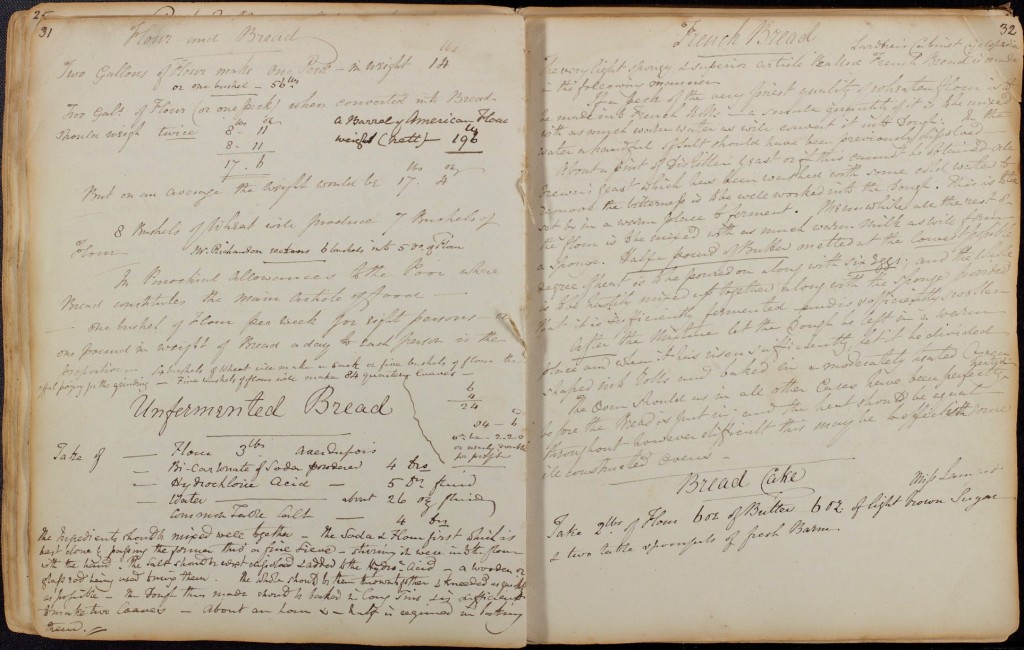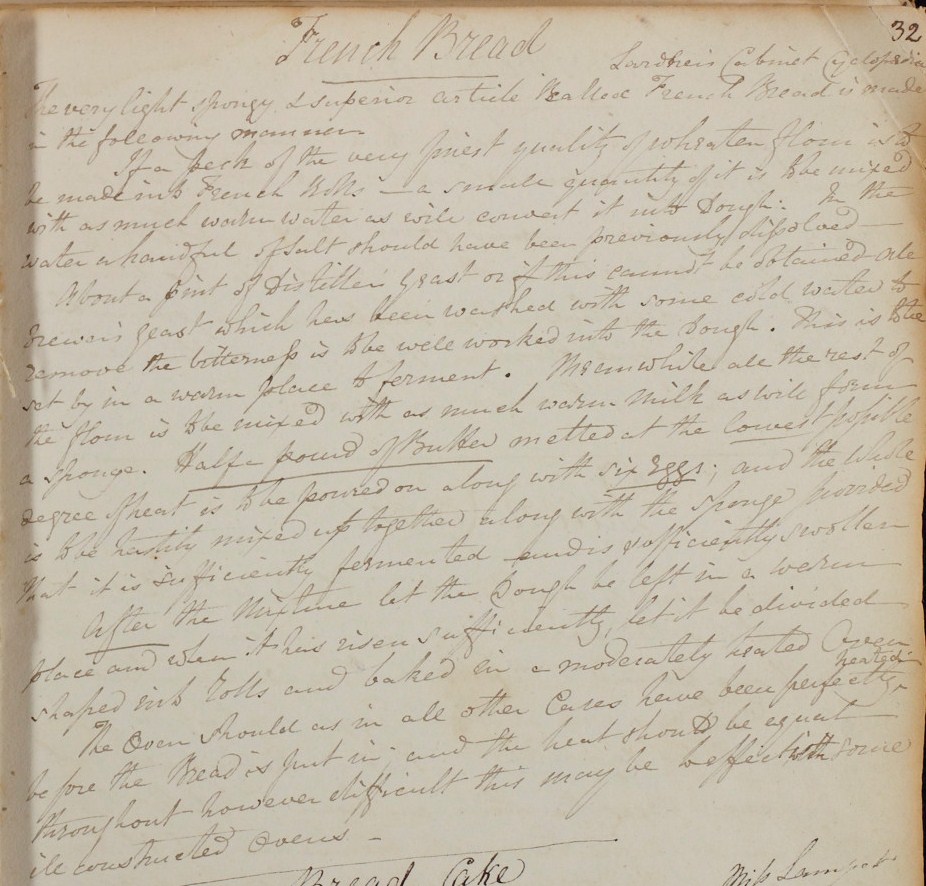It has been quite a long time since we supplied you all with some intriguing, interesting and surprising recipes from our archive. So with it being “Bread Week” on the Great British Bake Off your humble correspondent scurried off into the repositories here at the ERO in search of bread recipes returning triumphantly with two corkers!
They are both found within the pages of the Lampet family recipe book. Though the volume is undated and the recipes are in a number of different hands, it is likely that they stem from the 1830s as one of the recipes is said to be copied from Lardner’s Cabinet Cyclopedia which was first published in 1830.

T/B 677/2 – This page, devoted to bread and flour, also has lists of measurements of flour for the purposes of poor relief.
The first recipe as we teased on Twitter does indeed include a certain quantity of hydrochloric acid; no wonder you are instructed to knead the dough very quickly! It is for an “unfermented bread” using only baking soda as a raising agent; it would be similar to a normal soda bread were it not for the acid. Does anyone out there know what the acid was intended to do in this bake?
Take of –Flour 3lbs averdupois-Bi-Carbonate of Soda powdered 4 dram
-Hydrochloric acid – 5 drams fluid
-Water- about 26oz fluid
-Common Table Salt – 4 drams
The ingredients should be mixed well together – The Soda & flour first which is best done by passing the former thro[ugh] a fine sieve – stirring it well into the flour with the hand. The salt should be next dissolved & added to the Hydro[chloric]-Acid – a wooden or glass rod being used to mix them. The whole should be then thrown together & kneaded as quick as possible – The Dough thus made should be baked in long Tins and is sufficient to make two loaves – about an hour & a half is required in baking them.
The second recipe is something a bit less unusual. It is titled as a “French Bread” but on closer inspection it appears to be a form of brioche using a carefully prepared starter dough. Note the curious use of the word sponge while referring to the mixture. I am also reliably informed that a “peck” is two (dry) gallons. This recipe originates from Lardner’s Cabinet Cyclopedia and appears to be in the same hand as many of the recipes attributed to one Miss Lampet, although it is difficult to ascertain exactly who that is. It also has very few exact measurements, so it reads a bit like one of Paul Hollywood’s technical challenges!
The very light spongy & superior article called French Bread is made in the following manner.
If a peck of the very finest quality of wheaten flour is to be made into French rolls – a small quantity of it is to be mixed with as much warm water as will convert it into dough. In the water a handful of salt should have been previously dissolved-
About a pint of distillen yeast or if this cannot be obtained ale Brewer’s yeast which has been washed with some cold water to remove the bitterness is to be well worked into the dough. This is to be set by in a warm place to ferment. Meanwhile all the rest of the flour is to be Mixed with as much warm milk as will form a sponge. Half pound of Butter melted at the lowest possible degree of heat is to be poured on along with six eggs; and the whole is to be hastily mixed up together along with the sponge provided that it is sufficiently fermented and is sufficiently swollen
After the mixture let the dough be left in a warm place and when it has risen sufficiently let it be divided shaped into rolls and baked in a moderately heated Oven. The oven should as in all other cases have been perfectly heated before the Bread is just in and the heat should be equal throughout however difficult this may be to effect this in some ill constructed ovens.
So there you go, if you do try out the first one, we accept no liability for any acid burns. Also this whole recipe book amongst some others is available to view on our catalogue Seax. So have a go at some of the recipes and let us know how you get on! Finally, apologies for any transcription errors.

![T/B 677/2 - Unfermented Bread Take of –Flour 3lbs averdupois -Bi-Carbonate of Soda powdered 4 dram -Hydrochloric acid – 5 drams fluid -Water- about 26oz fluid -Common Table Salt – 4 drams The ingredients should be mixed well together – The Soda & flour first which is best done by passing the former thro[ugh] a fine sieve – stirring it well into the flour with the hand. The salt should be next dissolved & added to the Hydro[chloric]-Acid – a wooden or glass rod being used to mix them. The whole should be then thrown together & kneaded as quick as possible – The Dough thus made should be baked in long Tins and is sufficient to make two loaves – about an hour & a half is required in baking them.](http://www.essexrecordofficeblog.co.uk/wp-content/uploads/2014/08/T-B-677-2-a.jpg)
